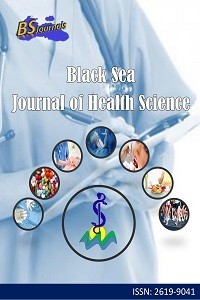Short-term Forecasts of the COVID-19 Epidemic in Turkey: March 16–28, 2020
Short-term Forecasts of the COVID-19 Epidemic in Turkey: March 16–28, 2020
COVID-19, Reproductive number, Growth curve Turkey,
___
- Bianconi A, Marcelli A, Campi G, Perali A. 2020. Ostwald growth rate in controlled Covid-19 epidemic spreading as in arrested growth in quantum complex matter. arXiv:2003.08868. Jung S, Akhmetzhanov AR, Hayashi K, Linton NM, Yang Y, Yuan B, Kobayashi T, Kinoshita R, Nishiura H. 2020. Real-time estimation of the risk of death from novel coronavirus (COVID-19) Infection: Inference using exported cases. J Clin Med, 9: 523, DOI: 10.3390/jcm9020523. Lipsitch M, Cohen T, Cooper B, Robins JM, Ma S, James L, Gopalakrishna G, Chew SK, Tan CC, Samore MH, et al. 2003. Transmission dynamics and control of severe acute respiratory syndrome. Science, 300: 1966–1970. Liu Y, Gayle AA, Wilder-Smith A, Rocklöv J. 2020. The reproductive number of COVID-19 is higher compared to SARS coronavirus. J Travel Med, 2020: 1–4, DOI: 10.1093/jtm/taaa02. Richards F. 1959. A flexible growth function for empirical use. J Exp Bot, 10: 290–301. Roosa K, Luo R, Chowell G. 2019. Comparative assessment of parameter estimation methods in the presence of overdispersion: A simulation study. Math Biosci Eng, 16: 4299–4313. Roosa K, Lee Y, Luo R, Kirpich A, Rothenberg R, Hyman JM, Yan P, Chowell G. 2020a. Real-time forecasts of the COVID-19 epidemic in China from February 5th to February 24th, 2020. Infect Disease Modell, 5: 256e263. DOI: 10.1016/j.idm.2020.02.002. Roosa K, Lee Y, Luo R, Kirpich A, Rothenberg R, Hyman JM, Yan P, Chowell G. 2020b. Short-term forecasts of the COVID-19 epidemic in Guangdong and Zhejiang, China: February 13–23, 2020. J Clin Med, 9: 596, DOI:10.3390/jcm9020596. Tian S, Hu N, Lou J, Chen K, Kang X, Xiang Z, Chen H, Wang D, Liu N, Liu D, Chen G, Zhang Y, Li D, Li J, Lian H, Niu S, Zhang L, Zhang J. 2020. Characteristics of COVID-19 infection in Beijing. J Infect, 80: 401–406, DOI: 10.1016/j.jinf.2020.02.018. Tunç T, Enöz S. 2018. Analysis of job satisfaction levels of police with structural eqution modeling: the case of Samsun. BSJ Eng Sci, 1(4): 134-139. Viboud C, Simonsen L, Chowell G. 2016. A generalized-growth model to characterize the early ascending phase of infectious disease outbreaks. Epidemics, 15: 27–37. Wang X-S, Wu J, Yang Y. 2012. Richards model revisited: Validation by and application to infection dynamics. J Theor Biol, 313: 12–19. Wu Z, McGoogan JM. 2020. Characteristics of and important lessons from the coronavirus disease 2019 (COVID-19) outbreak in China. JAMA, DOI: 10.1001/jama.2020.2648.
- Yayın Aralığı: Yılda 4 Sayı
- Başlangıç: 2018
- Yayıncı: Cem TIRINK
Multi-Perspective Investigation of Paroxysmal Nonepileptic Events Retrospectively
Hatice MUTLU ALBAYRAK, Haydar Ali TAŞDEMİR
Implant Surgery-Characterized by Extensive Ecchymosis: A Case Report
Musa SADİKHOV, Özlem GERGİNOK, Sevil KAHRAMAN
Short-term Forecasts of the COVID-19 Epidemic in Turkey: March 16–28, 2020
